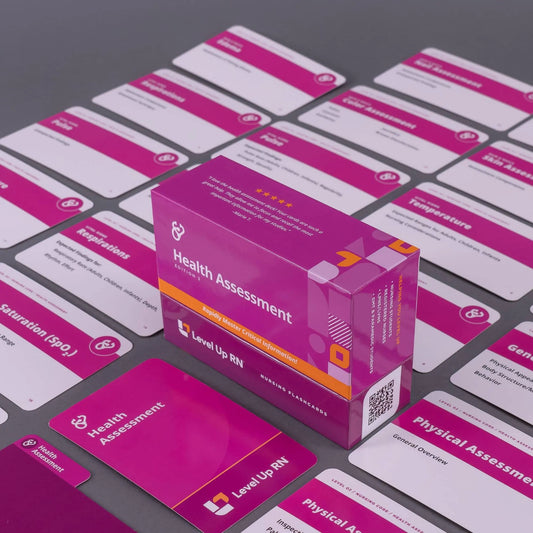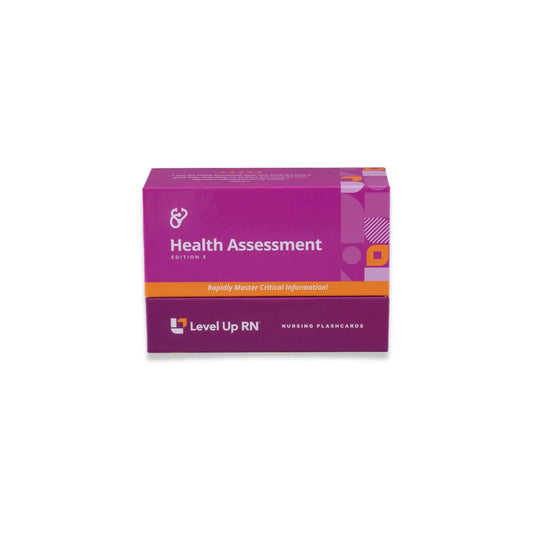Health Assessment, part 14: Nail Assessment
Updated: Meris ShuwargerImportant components of assessing a patient's nails and reviews nail clubbing and capillary refill
Full Transcript: Health Assessment, part 14: Nail Assessment
Full Transcript: Health Assessment, part 14: Nail Assessment
Hi, I'm Meris. And in this video, I'm going to be covering how to assess your patient's nails. I'll be covering expected findings and unexpected findings. I'm going to be following along using the flashcards from our health assessment deck. These are available on our website, leveluprn.com, if you want to grab a set for yourself. And if you already have your own, I would invite you to pull it out and follow along with us. All right, let's get started.
So first up, let's talk about just what the assessment components are. So we're going to inspect using our eyes. We're going to inspect the size, shape, thickness, cleanliness of the nails. That's going to give us a lot of information right away. We're going to assess the angle between the nail plate and the skin. So the nail plate is right here, the skin is here. We are looking to see what that angle is. The expected finding is for it to be less than 160 degrees. Then we're also going to assess something called capillary refill, which we would expect would be less than or equal to two seconds.
Now, let's talk about what capillary refill is. It kind of is what it sounds like. It's how long does it take for your capillary beds to refill with blood once we displace that blood. So how do we do that? Well, we're going to take our patient's nail, and we're going to pinch down on the nail. And do you see how it turns white there? That's because I've displaced all of the blood that's in the capillaries by putting pressure on that. So we're going to do that. We're going to hold it down, and then we're going to let go and see how long it takes for the capillary bed to refill. As you could see, mine was almost instantaneous. I don't think it even took a second. And so that would be good cap refill is how we often refer to it. And that would be a normal expected finding. However, we'll talk about what it means when that is not the case.
So now we're going to talk about the unexpected findings associated with a nail assessment. So if we see patients who have excessively thick nails, this could tell us that they have poor blood flow to the area. So maybe they have peripheral arterial disease, for instance, or it could be caused by a fungal infection. So we may need to investigate further to see if it's something that would require treatment with an antifungal. Now, let's talk about what happens if that angle of our nail plate to the skin is greater than 160 degrees. We call that profile sign. And it can also just be called clubbing. There's also something called the Schamroth test that has to do with putting the nails together. So you may hear it brought up in many different ways. And certainly, however your school refers to it is what you need to know.
Now, before I get into this next thing, I want to tell you that this is not perhaps the most evidence-based information that is available to us in this day and age. However, however, we know that it takes time for EBP to make its way into the educational world. So the thing that I'm about to tell you is perhaps not accurate, but is very likely to be something that you are taught and tested on in nursing school and on the NCLEX, okay? So I know, I know, that there's going to be a lot of people unhappy that I'm saying this, but I want to put that disclaimer out there so that you know that we're aware, but you may still need to know this.
So this part is accurate. Clubbing of the nails can indicate chronic hypoxia. That is a possible cause of it. However, typically that's going to be associated with different types of lung infections, different types of tumors, things of that nature. It is also associated with COPD, chronic obstructive pulmonary disease. And you must know, for your nursing school exams and the NCLEX, that clubbing or a positive profile sign is a finding associated with COPD. So if you had a select all that apply question, it's very possible, very likely that clubbing would be there as an option, okay? Now, if what I have just said is not true for your school, your institution, that's fantastic. Scratch it off on the card, you don't need to know it. However, it is still being tested in NCLEX at this time.
So anyway, clubbing, lots of different causes. It is not diagnostic. It doesn't tell us, "Aha, this is what's wrong with your patient." Clubbing tells us something is going on and we have developed this. It could be cardiovascular. When I do TikToks and I do anything upclose and people see my nails, they always say, why do you have clubbing? And I absolutely do have clubbing. And I can tell you we don't know why. I have had clubbing present since birth. It's not huge clubbing, the way that you will see in some patients. But I mean, you can see that my nail is-- sorry, I'm trying to show you. My nail is rounded at the top. Some people just have it. It's just idiopathic. It doesn't hurt anything. It's not a big deal. But if we see that really big, bulbous tip on the fingers, that really huge profile sign, that is a cause for further concern. No doctor has ever been concerned about the level of clubbing that I have. So just keep that in mind, that there's degrees of this.
Now, I told you, we're going to talk about capillary refill if it is longer than two seconds. So we've said that normal cap refill is less than or equal to two seconds. However, if we have cap refill-- if I go here and I push on that thumb and then let go and it takes more than two seconds to return, oh, something's going on here. And I'll tell you that as an ER nurse, delayed capillary refill to me is a very ominous sign, especially in a child. Especially in a child, but in anybody, it's an ominous sign. Some possible causes of delayed cap refill or prolonged cap refill, dehydration. So just because I don't have enough blood volume to rush back into the space because I'm low on plasma or I'm low on blood.
Shock, specifically hypovolemic shock. However, any shock, you could cause prolonged cap refill. Especially if you think about the fact that shock is commonly associated with hypotension. If I don't have enough pressure, if I'm not pushing the blood through the arteries and then the arterioles strongly enough, it's going to take time to get it to the capillary beds once I displace it. The pressure isn't there. I've got water trickling through a garden hose rather than coming up forcefully. And shock commonly has hypotension associated.
Hypothermia. If I'm cold, right, I'm going to have vasoconstriction. So even if everything is good, everything is normal, if I'm very cold and vasoconstricted, it's going to take more time to get the blood into the capillaries, just because they're smaller. They're skinny now because we have vasoconstricting. And then again, peripheral arterial disease. If we have a problem getting the blood down to our extremity, well then we could see cap refill being delayed. You can check cap refill on the fingers or on the toes.
Now, keep in mind, if I'm checking cap refill and it's prolonged, but I feel the patient's thumb and it's very cold, they're cold, they've been outside working or something like that, I'm not necessarily going to panic if they otherwise seem stable. However, if I'm caring for somebody and they are not looking good and they are gray, they're sweaty, they just look like they're about to crump and they have delayed cab refill, I'm getting nervous, okay? So this is something that I assess on every patient every time. It's very quick and easy. It doesn't have to be a prolonged assessment. It's just a quick pinch of the finger. So that is a very good way for me to assess the underlying cardiovascular status of my patient by just using their nails.
All right, I got some quiz questions to help you test your knowledge of key facts I provided in this video.
The nurse assesses a patient's capillary refill and finds that it takes two seconds. Is this a normal or abnormal finding? This is a normal finding.
A patient has a 180 degree angle between the nail plate and the skin. How should the nurse document this finding? This is clubbing.
How may shock affect a patient's capillary refill? Shock may prolong a patient's capillary refill.
All right, that is it for the nail assessment. I hope you will join me in the next video where we move on to assessing the head and face. You're doing a really great job, and I'm super proud of you. Thanks for studying with me.



1 comment
Help me with assessment of integumentary system assessment